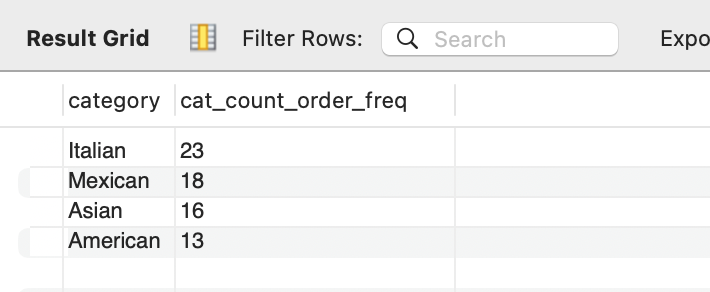Kristen Healy

World Café Menu Analysis
Kristen Healy
2024-05-20
Assignment
The fictional Taste of the World Café, a restaurant serving international cuisine, debuted a new menu at the beginning of the year. The business owner wants to get an understanding of how the new menu items are doing with customers: which items are doing well and which are not, and what its top customers seem to like best.
Because the owner wants the information quickly and the data is in a MySQL database, all of the analysis will be done in SQL.
Note: I used “top orders” as a proxy for “top customers” since we have order- and item-level data but not customer-level data.
Data Overview
We have 3 months of order data–from January through March, with 5370 total orders and 12,234 items ordered. The 7 top orders by item count had 14 items on them, and 20 orders had more than 12 items. January and March had similar order numbers (1800+), while there was a dip in February (<1700). Total revenue for the period was $159,217.
The menu has 32 items across 4 different international cuisines:
- Italian (9)
- Asian (8)
- Mexican (9)
- American (6)
The Asian category had the most items ordered at 3470, followed by Italian (2948), Mexican (2945), and American (2734). Interestingly, although the American category trailed the rest, which is unsurprising since the category has the fewest items, 3 of the most frequently ordered items were in that category:
- Hamburger, $12.95
- Edamame, $5
- Korean Beef Bowl, $17.95
- Cheeseburger, $13.95
- French Fries, $7
Prices range from $5 (Edamame) to $19.95 (Shrimp Scampi), with an average menu item price of $13.29. Italian is the highest-priced category on average ($16.75), followed by Asian ($13.48), Mexican ($11.82), and American ($10.33).
Given that, it wasn’t suprising to find that the top 5 orders by spend (>$185) ordered heavily from the Italian category:
- Italian, 26 items
- Asian, 17 items
- Mexican, 16 items
- American, 10 item
Recommendations and Next Steps
Although the American category has the lowest average prices, the items in this category are ordered frequently by customers as a whole. Although our top spenders order “American” items less often, I would recommend leaving the category largely as is because it’s driving both revenue and order numbers. The cheeseburger and hamburger, for example are among our top 5 items by revenue.
The Mexican category, however, needs changes. I would recommend eliminating both the Chicken Tacos and the Cheese Quesadillas from the menu since they’re performing poorly. The tacos were ordered only once by our highest spenders and is the least popular item amongst all customer orders, despite its relatively low price ($11.95). Similarly the quesadillas ($10.95) were the 5th least popular item overall and weren’t ordered at all by our highest spenders.
Overall, both the Italian and Asian categories are doing well. They are the top 2 categories by revenue, and are broadly popular judged by order item count. Therefore, I don’t recommend any immediate changes to either of these categories.
Next steps: I’d like to conduct a customer survey to get some additional information from our customers about what changes they’d like to see on our menu. I’ll set up a meeting with you and the executive chef to discuss the parameters.
Query Details
The restaurant database consists of 2 tables:
- menu_items
- order_detail
Menu Items Table
The menu_items table included the following columns:
- menu_item_id
- item_name
- category
- price
/* set restaurant_db as the my default db */
USE restaurant_db;
/* preliminary view of the table */
SELECT *
FROM menu_items;
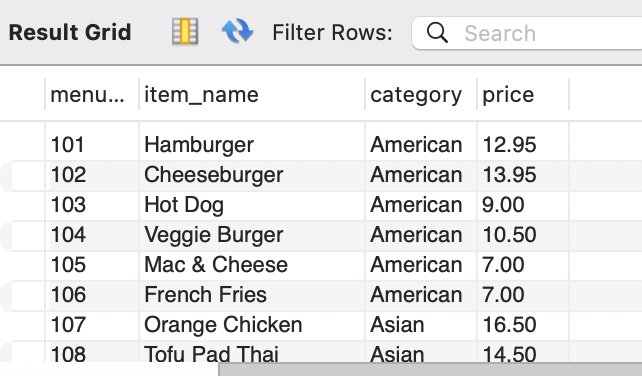
/* number of menu items and categories */
SELECT
COUNT(menu_item_id) AS num_items,
COUNT(DISTINCT category) AS num_categories
FROM menu_items;
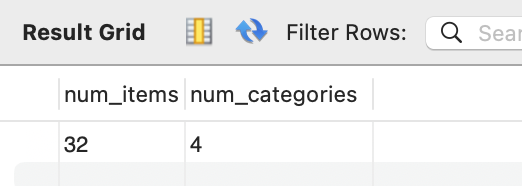
/* Summary menu item pricing info */
SELECT
MAX(price) AS highest_price,
MIN(price) AS lowest_price,
ROUND(AVG(price),2) AS avg_price,
(SELECT price
FROM menu_items
GROUP BY price
ORDER BY COUNT(*) DESC, price DESC
LIMIT 1) AS most_frequent_price
FROM menu_items;

/* What are the least expensive items on the menu?*/
SELECT
item_name,
category,
price
FROM
menu_items
ORDER BY
price
LIMIT 5;
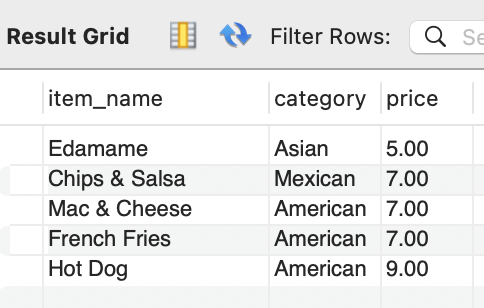
/* What are the most expensive items on the menu*/
SELECT
item_name,
category,
price
FROM
menu_items
ORDER BY
price DESC
LIMIT 5;

/* summary pricing info by category */
SELECT
category,
COUNT(menu_item_id) AS num_items,
MAX(price) AS most_expensive,
MIN(price) AS least_expensive,
ROUND(AVG(price),2) AS avg_price
FROM menu_items
GROUP BY category
ORDER BY avg_price DESC, num_items DESC;

Orders Table
The table contains rows for each order_details_id. The order_details table included the following columns:
- order_details_id
- order_id
- order_date
- order_time
- item_id
/* view order details table */
SELECT *
FROM
order_details;
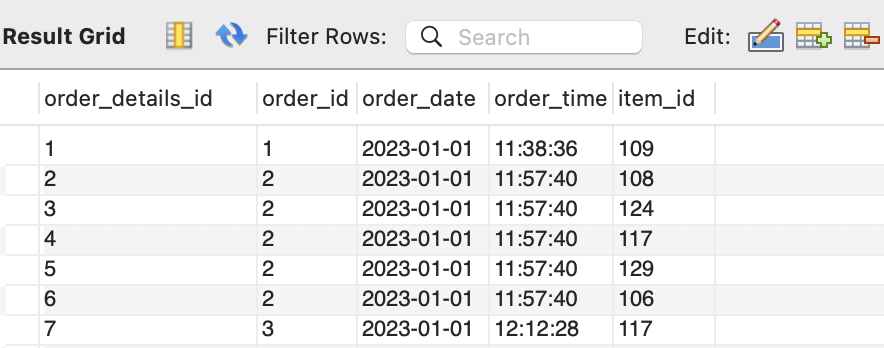
/* What order dates are included in the table? */
SELECT
MIN(order_date) AS first_date,
MAX(order_date) AS last_date
FROM
order_details;

/* How many orders?
How many items were ordered?
*/
SELECT
COUNT(DISTINCT order_id) AS num_orders,
COUNT(order_details_id) num_order_items
FROM order_details;
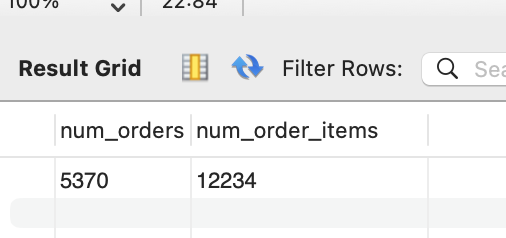
/* Which orders had the most items? */
SELECT
order_id,
COUNT(item_id) AS num_items
FROM
order_details
GROUP BY
order_id
ORDER BY
num_items DESC;
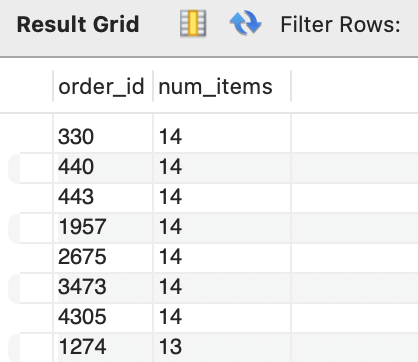
/* How many orders had more than 12 items: */
SELECT COUNT(*) FROM
(SELECT
order_id,
COUNT(item_id) AS num_items
FROM
order_details
GROUP BY
order_id
HAVING
num_items > 12) AS num_orders;
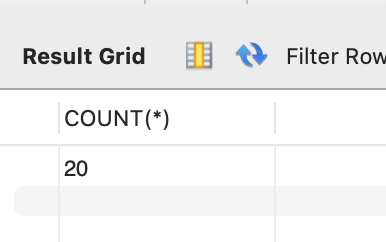
/* Are there any differences in order/item counts by month? */
SELECT
MONTH(order_date) AS order_month,
COUNT(DISTINCT order_id) AS num_orders,
COUNT(item_id) AS num_items
FROM order_details
GROUP BY order_month;
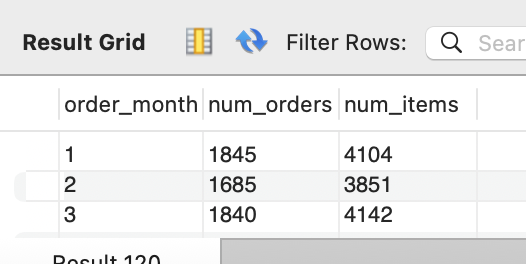
Combined Data
After becoming familiar with the two tables, I joined them for further analysis.
/* Create view combining the menu_items table and the order_details table.
We'll use this in other queries.
*/
CREATE VIEW full_order_details AS
SELECT *
FROM
order_details
LEFT JOIN menu_items
ON order_details.item_id = menu_items.menu_item_id;
SELECT *
FROM
full_order_details;

/* most often ordered (items)*/
SELECT
item_name,
category,
price,
COUNT(item_id) AS item_count
FROM
full_order_details
GROUP BY
item_name,category,price
ORDER BY
item_count DESC;
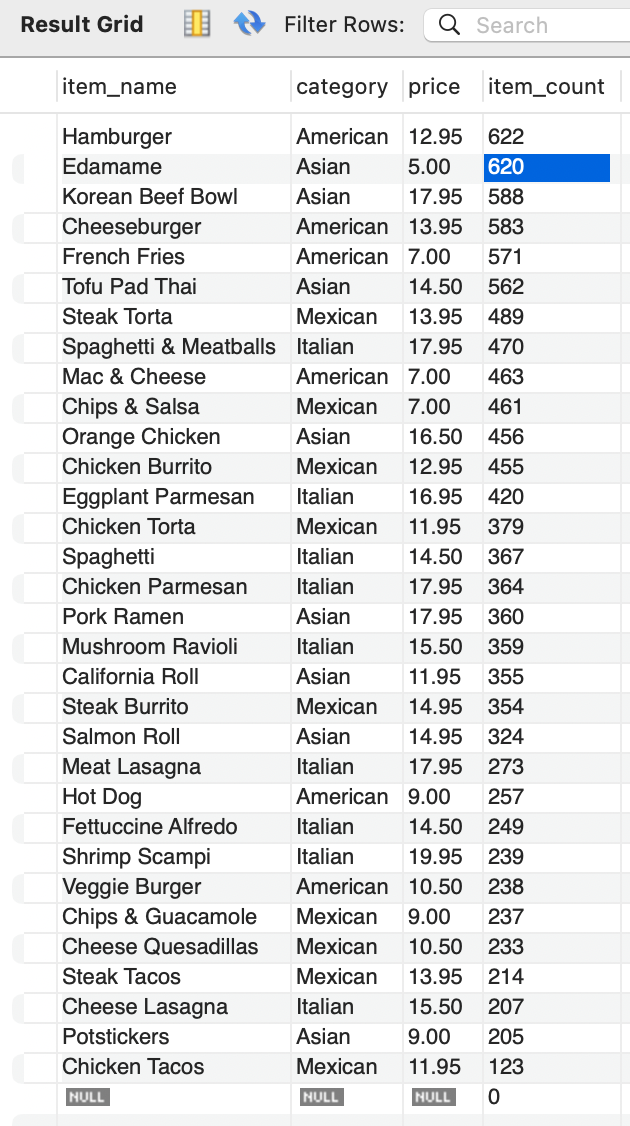
/* most often ordered (categories)*/
SELECT
category,
ROUND(AVG(price),2) AS avg_price,
COUNT(category) AS cat_count
FROM
full_order_details
GROUP BY
category
ORDER BY
cat_count DESC;
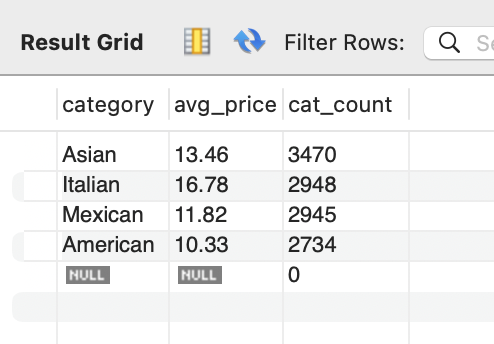
/* items by revenue */
SELECT
item_name,
category,
price,
SUM(price) AS item_revenue,
COUNT(item_id) AS item_count
FROM
full_order_details
GROUP BY
item_name,category,price
ORDER BY
item_revenue DESC;
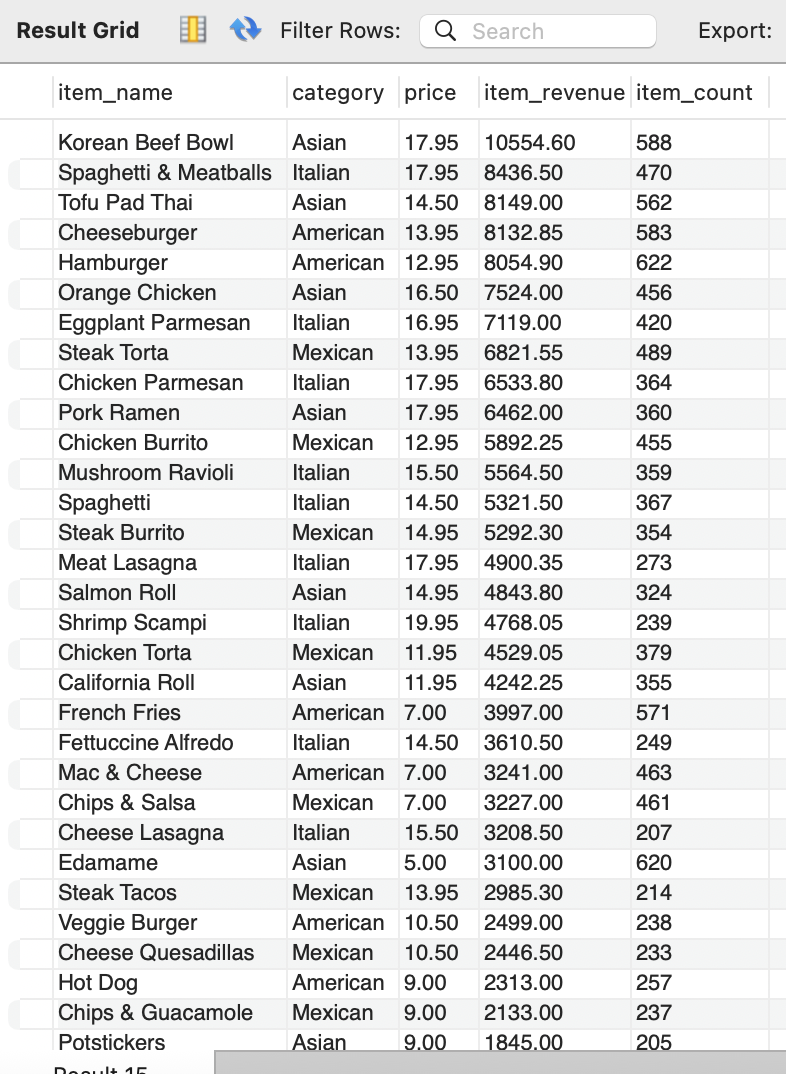
/* category revenue */
SELECT
category,
SUM(price) AS category_revenue
FROM
full_order_details
GROUP B
category
ORDER BY
category_revenue DESC;
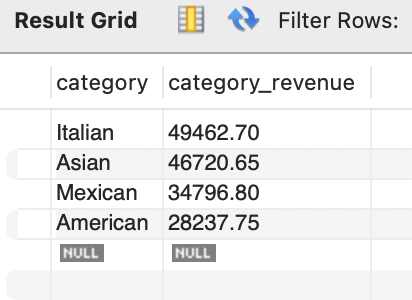
/* total revenue */
SELECT
SUM(price) AS total_revenue
FROM
full_order_details;
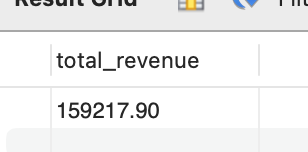
/* rank orders by highest spend */
SELECT
order_id,
SUM(price) AS total_price
FROM
full_order_details
GROUP BY order_id
ORDER BY total_price DESC;
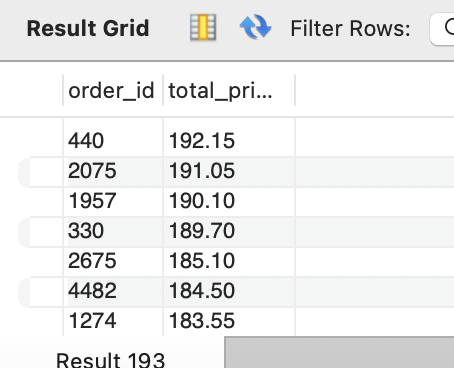
/* rank orders by highest number of items with order total as tiebreaker */
SELECT
order_id,
COUNT(item_id) AS item_count
FROM
full_order_details
GROUP BY order_id
ORDER BY item_count DESC, SUM(price) DESC;
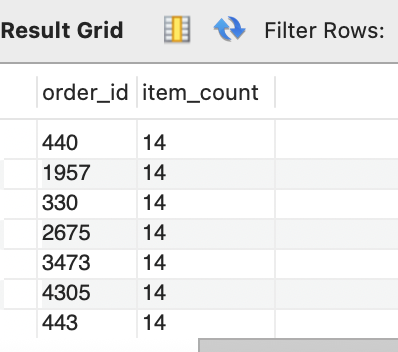
/* order 2075 was in the top 5 by spend but not by total items...
order 3473 was in the top 5 by total items but not by spend...
what was on these 2 orders?
*/
SELECT
order_id,
item_name,
category,
COUNT(item_id),
price
FROM
full_order_details
WHERE
order_id
IN (2075,3473)
GROUP BY 1,2,3,5
ORDER BY order_id, price DESC;
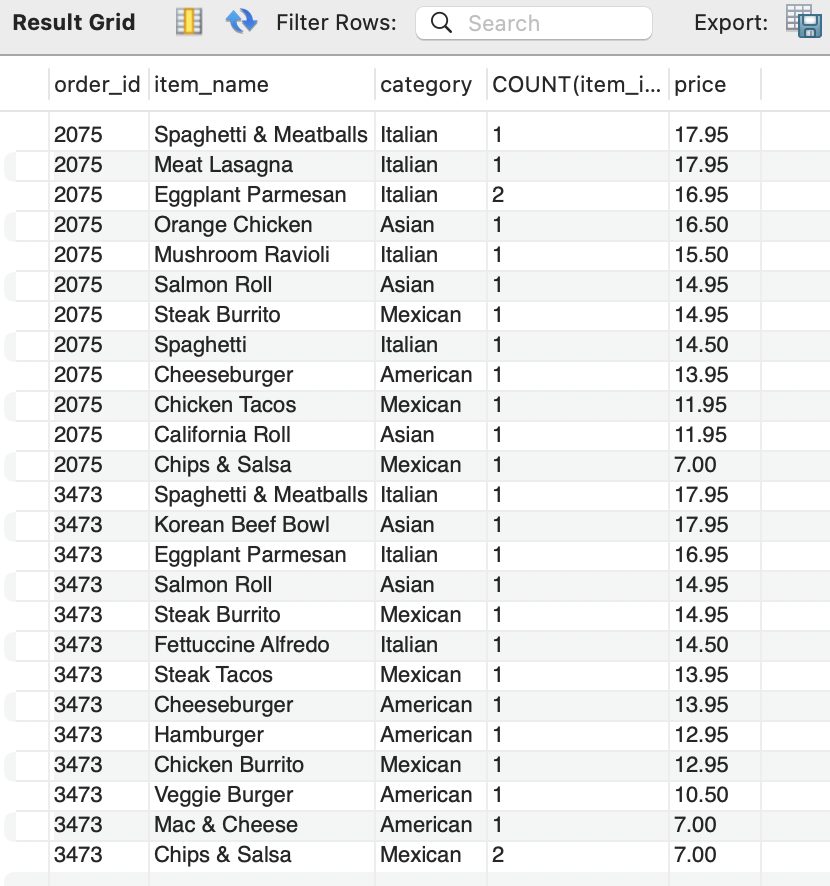
/* order details of highest spend order */
SELECT
order_id,
category,
item_name,
price,
COUNT(item_name) num_items
FROM
full_order_details
WHERE
order_id =
(SELECT order_id
FROM
full_order_details
GROUP BY order_id
ORDER BY SUM(price) DESC
LIMIT 1) -- returns order id of the order with the highest order total
GROUP BY order_id,category,item_name, price
ORDER BY num_items DESC;
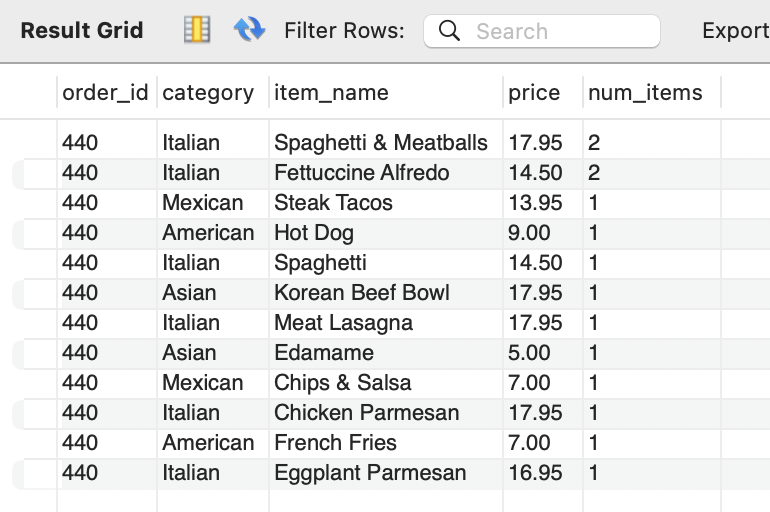
/* category count for top order by spend */
SELECT
order_id,
category,
COUNT(category) AS items_in_cat
FROM
full_order_details
WHERE
order_id =
(SELECT order_id
FROM
full_order_details
GROUP BY order_id
ORDER BY SUM(price) DESC
LIMIT 1)
GROUP BY order_id, category
ORDER BY items_in_cat DESC;
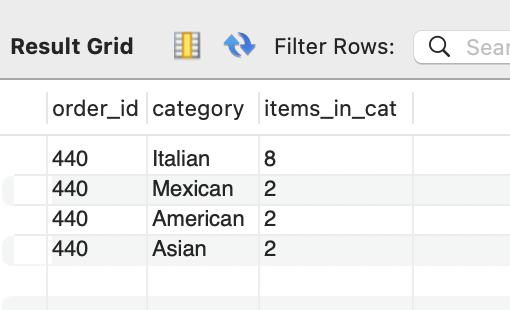
/* items from top 5 orders by spend*/
WITH top_five AS
(SELECT
order_id
FROM
full_order_details
GROUP BY order_id
ORDER BY SUM(price) DESC
LIMIT 5)
SELECT
category,
item_name,
price,
COUNT(item_name) num_items
FROM
full_order_details
WHERE
order_id IN
(SELECT order_id
FROM
top_five)
GROUP BY category,item_name, price
ORDER BY num_items DESC;

/* items from 5 top orders by item count*/
WITH top_five AS
(SELECT
order_id
FROM
full_order_details
GROUP BY order_id
ORDER BY COUNT(item_id) DESC, SUM(price) DESC
LIMIT 5)
SELECT
category,
item_name,
price,
COUNT(item_id) num_items
FROM
full_order_details
WHERE
order_id IN
(SELECT order_id
FROM
top_five)
GROUP BY category,item_name, price
ORDER BY num_items DESC;
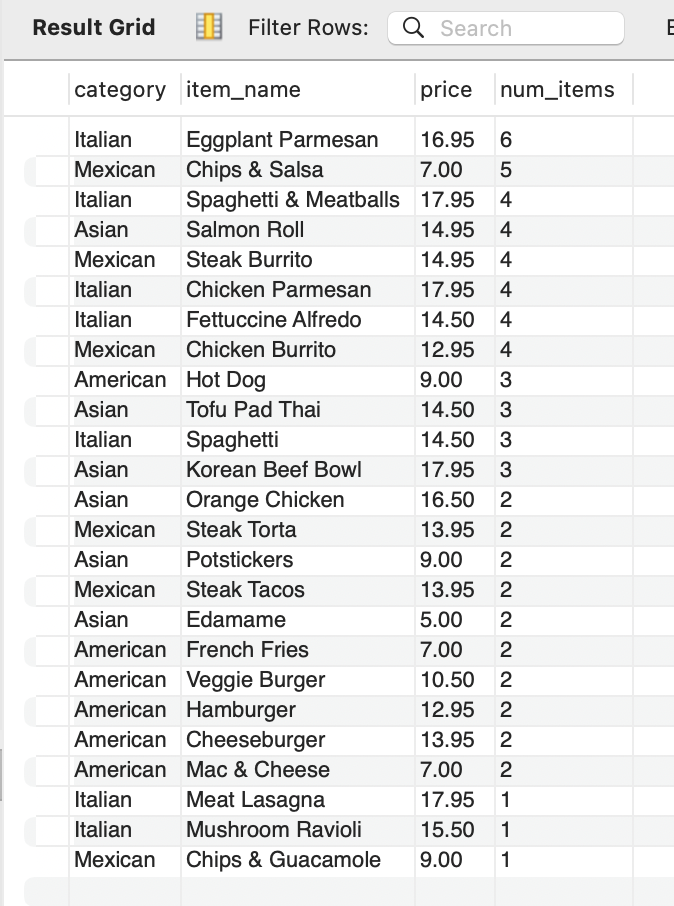
/* category count for top 5 orders by spend*/
WITH top_five AS
(SELECT
order_id
FROM
full_order_details
GROUP BY order_id
ORDER BY SUM(price) DESC
LIMIT 5)
SELECT
category,
COUNT(category) cat_count_order_freq
FROM
full_order_details
WHERE
order_id IN
(SELECT order_id
FROM
top_five)
GROUP BY category
ORDER BY cat_count_order_freq DESC;
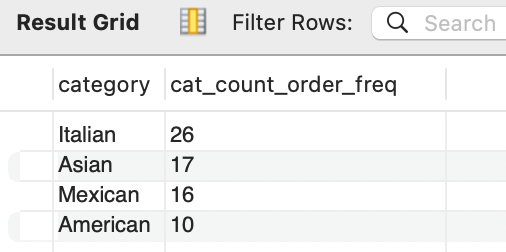
/* category count for top 5 orders by item count*/
WITH top_five AS
(SELECT
order_id
FROM
full_order_details
GROUP BY order_id
ORDER BY COUNT(item_id) DESC, SUM(price) DESC
LIMIT 5)
SELECT
category,
COUNT(category) cat_count_order_freq
FROM
full_order_details
WHERE
order_id IN
(SELECT order_id
FROM
top_five)
GROUP BY category
ORDER BY cat_count_order_freq DESC;
